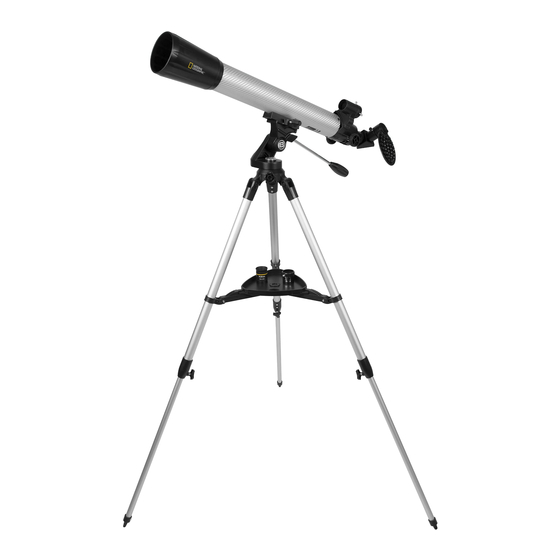Advertisement
70/700MM
70 mm Carbon Fiber Telescope
w/ Pan Handle Mount
Instruction Manual
Optical design
Magnification (with 2x Barlow lens)
Front lens (clear aperture)
Focal length
Standard eyepieces
Finish
Accepts eyepiece barrel
Mounting
WARNING:
SUN HAZARD — Never look directly at the sun
with this device.
Visit us at: nationalgeographic.com
WARNING:
CHOKING HAZARD — Small parts.
Not for children under 3 years.
1
80-40071 / 80-40071CF
Achromatic refractor
26.9 - 72x (52 - 144x)
70 mm
700 mm/f10
Plössl 26 mm and 9.7 mm
Carbon fiber
31.7 mm (1.25")
AZ Pan Handle Mount
1
X
CR2032
3V
INCLUDED
WARNING:
Contains button or coin cell battery.
Hazardous if swallowed — see instructions.
AGES
10 +
Advertisement
Table of Contents

Summary of Contents for National Geographic 80-40071
- Page 1 AGES 10 + Visit us at: nationalgeographic.com 80-40071 / 80-40071CF 70/700MM 70 mm Carbon Fiber Telescope w/ Pan Handle Mount Instruction Manual Optical design Achromatic refractor Magnification (with 2x Barlow lens) 26.9 - 72x (52 - 144x) Front lens (clear aperture)
-
Page 2: Sun Warning
National Geographic’s net proceeds support vital exploration, conservation, research, and education programs. SUN WARNING WARNING: NEVER ATTEMPT TO OBSERVE THE SUN WITH THIS DEVICE! OBSERVING THE SUN – EVEN FOR A MOMENT – WILL CAUSE INSTANT AND IRREVERSIBLE DAMAGE TO YOUR EYE OR EVEN BLINDNESS. Eye damage is often painless, so there is no warning to the observer that the damage has occurred until it is too late. -
Page 3: How To Set Up
Visit us at: nationalgeographic.com How To Set Up Note: We recommend assembling your telescope for the first time in the daylight or in a lit room so that you can familiarize yourself with assembly steps and all components. 4b1) 4b2) 10a) 10b) 10c) -
Page 4: Parts Overview
National Geographic’s net proceeds support vital exploration, conservation, research, and education programs. Parts Overview 1. 70mm Objective Lens 2. Pan-Tilt Alt-Azimuth Mount 3. Tripod with Accessory Tray 4. Optical Tube Assembly (OTA) with Dew Shield 5. Focus Wheel 6. Diagonal 7. -
Page 5: Using Your Telescope
Visit us at: nationalgeographic.com Eyepiece: An eyepiece is a system made for your eye and comprised of one or more lenses. In an eyepiece, the clear image that is generated in the focal point of a lens is captured and magnified still more. Magnification: The magnification corresponds to the difference between observation with the naked eye and observation through a magnifying device like a telescope. - Page 6 National Geographic’s net proceeds support vital exploration, conservation, research, and education programs. Terrestrial Images Possible Objects for Observation: f=26 mm f=9.7 mm Terrestrial objects Take note of the examples below, including Mount Rushmore and the golf course. Start with the 26 mm eyepiece and focus until the image is clear. After mastering the 26 mm eyepiece, switch to the 9.7 mm eyepiece and practice scanning and...
-
Page 7: Troubleshooting Guide
Visit us at: nationalgeographic.com Troubleshooting Guide: No picture Remove dust protection cap and sun-shield from the objective opening. Blurred picture Adjust focus using focus ring. No focus possible Wait for temperature to balance out. Bad quality Never observe through a glass surface such as a window. Viewing object visible in the finder, but not Align finder to telescope (see instructions) through the telescope... - Page 8 National Geographic’s net proceeds Visit us at: nationalgeographic.com support vital exploration, conservation, research, and education programs. © 2017 National Geographic Partners LLC. All rights reserved. NATIONAL GEOGRAPHIC and Yellow Border Design are trademarks of the National Geographic Society, used under license.
















Need help?
Do you have a question about the 80-40071 and is the answer not in the manual?
Questions and answers